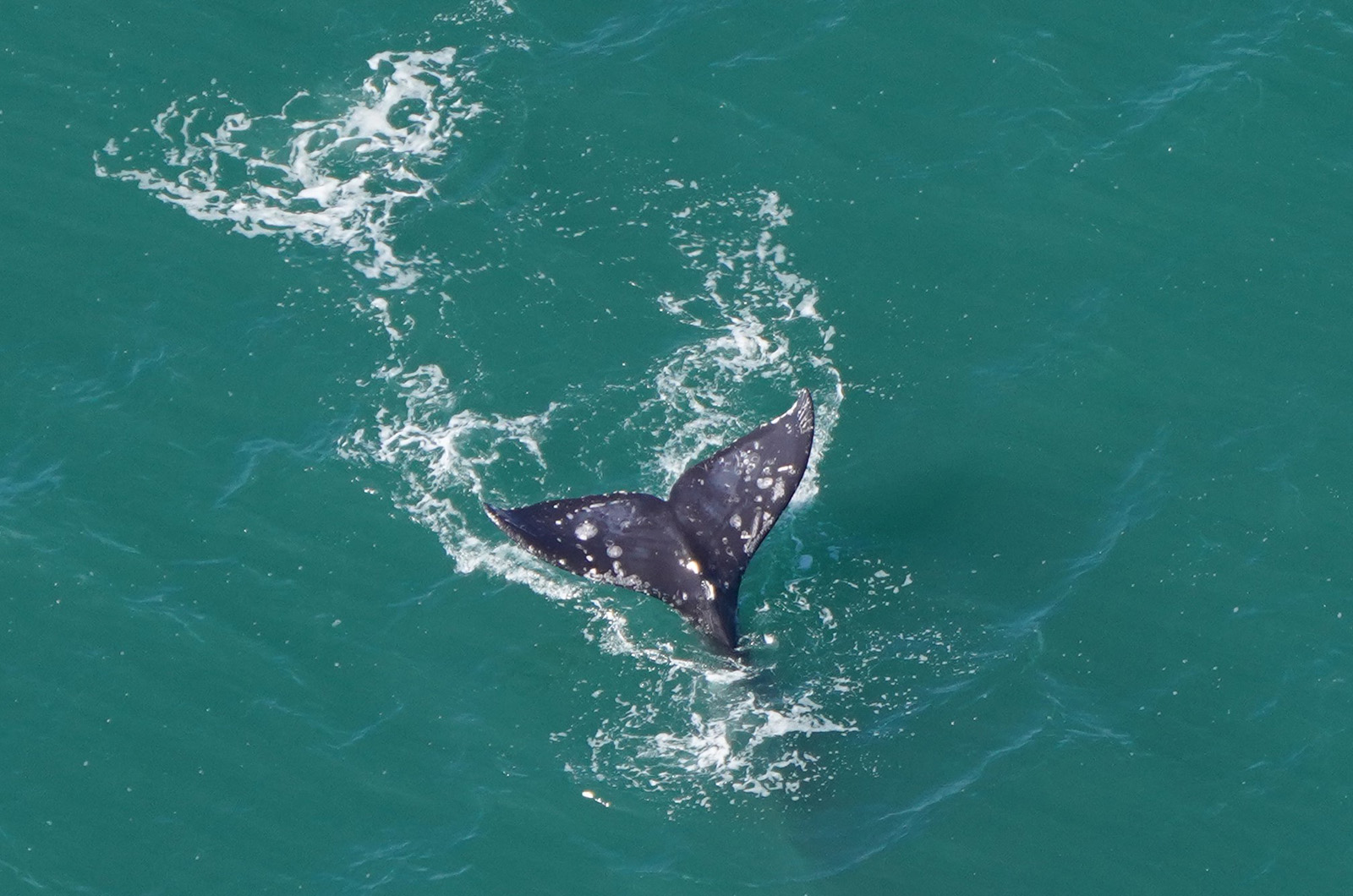In waters about 30 miles south of Martha’s Vineyard, a whale not seen in the region for more than two centuries was spotted from the skies last week by scientists with the New England Aquarium.
A gray whale, thousands of miles from its home in the Pacific, made itself known to a group of researchers conducting a plane-mounted aerial survey on March 1, when the whale repeatedly dove and resurfaced for 45 minutes while scientists observed.
“My brain was trying to process what I was seeing, because this animal was something that should not really exist in these waters,” said research technician Kate Laemmle, in a release from the aquarium. “We were laughing because of how wild and exciting this was.”
Though the species is now plentiful in the Pacific, from Baja California to the Arctic Circle, gray whales went extinct in the Atlantic Ocean around the 18th century. In recent decades, however, the whales have been intermittently spotted on this side of the continent, though never before in New England.
“There’s only been a handful of sightings,” said Orla O’Brien, another member of the survey team, in an interview with the Gazette.

In the early 2000s, she said one was spotted off the coast of Namibia in Africa, and another was seen in the Mediterranean a few years ago. This December, a gray whale was spotted near Miami, likely same individual that made an appearance near the Vineyard.
“Neither myself nor Kate...had ever seen a gray whale before because we work in the Atlantic. But if you have worked with whales for long enough, and you love whales, you know what some of the big ones look like, even if you haven’t seen them,” she said. “It was just kind of crazy, because we looked at it and we were like, ‘That’s a gray whale. But they don’t live here. So how is this possible?’”
The running theory among researchers, said Oregon State University affiliate and gray whale expert James Sumich, is that these so-called “wandering whales” are making their way west through arctic waters, as climate change contributes to less summertime ice coverage.
“With the Arctic being as ice free as long as it is now, every year, there’s simply no barrier for these guys,” he said. “I think that’s the most plausible explanation, because the only other explanation is that the North Atlantic gray whales never went extinct.”
Fossil evidence and eyewitness accounts indicate that the species was previously found from the Mediterranean to Georgia to Iceland, Mr. Sumich said, but detailed studies only began after the species had been hunted to extinction in the Atlantic.
The most recent sighting, he said, has caused a stir even among researchers who study the Pacific population, highlighting the enduring mysteries of the species’ behavior.
“This is another one of those very surprising events that has us all scratching our heads,” said Mr. Sumich, who has studied the creatures for 50 years. “These are unusual whales.”
And yet, a gray whale taking a long, inter-oceanic journey is in some ways unsurprising for the species, Mr. Sumich said. They are among the widest ranging of migratory whales in their normal habitat, traveling thousands of miles from arctic feeding grounds to warm water Baja lagoons during winter calving season.
“Why they do it is still an open question,” he said. “We don’t have any good explanation for the migrations.”
During the winter, he said, for reasons not well understood, the whales undergo an extended fasting period, ruling out the possibility that they migrate for food.
“They’re not only not feeding, they’re migrating five or six thousand miles, spending two or three months in warm subtropical lagoons and nursing a calf that weighs about a ton when it’s born,” he said. “The numbers are kind of amazing.”
The migratory behaviors of non-adult whales, and of errant gray whales in the Atlantic, are even less understood.
“One of our questions about these wandering whales that we’ve been seeing...is whether they’re doing the same thing. And we’re not sure.”
While the previous, “oddball” sightings off Namibia and in the Mediterranean were of whales displaying poor body condition, the recent individual near the Vineyard shows no such signs, perhaps indicating that it skipped the fast and fed throughout the winter.
On the other hand, Mr. Sumich said, if it really is the same individual as was spotted in Miami, the whale could be mirroring Pacific migration habits.
As to why it ended up in the wrong ocean to begin with, Mr. Sumich speculated that it might have something to do with declining conditions back home.
“The West Coast population near the North Pacific is into about the sixth year of a population declining. We’ve lost almost 46 per cent of the population,” he said, a decline in part attributable to climate change damaging their food supply.
“You would certainly expect to see is this emigration of animals out of areas of poor food conditions to at least look around for something else,” he said. “Maybe it’s surprising that it hasn’t happened more often.”
Gray whales are primarily bottom feeders, diving to the sea floor to scoop up sediment and filter out tiny crustaceans, a behavior unique among whales.
“If gray whales did get reestablished in the North Atlantic, there are several areas that seem to be appropriate,” he said. “We’re concerned about the numbers and the trends here in the North Pacific, and kind of thrilled that maybe there’s going to be a spillover effect into the North Atlantic.”
Meanwhile, as a group of astonished scientists continue to unpack the implications of this cetacean wanderer, the whale itself appears unfazed about its journey.
“It seems to just be living its life out here,” Ms. O’Brien said. “My wish for it is that it finds its way back to the Pacific. But for now, it seems like it’s doing okay.”







Comments (3)
Comments
Comment policy »